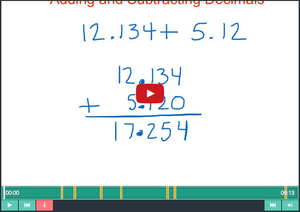How Teachers Can Create Videos That Engage Students
This is a guest post from one of eduCanon’s co-founders, Swaroop Raju. eduCanon is a platform that makes online videos interactive by allowing teachers to embed questions during the video, so students are actively learning and instructors can monitor understanding in real-time or in preparation for class.
As a teacher, you may think slick production is the way to go in building engaging learning videos, but data out of MIT’s edX shows that variables within your control (and budget!) have more of an impact. I’m going to display two different types of video lessons and I want you to consider which one would lead to higher student engagement:
Video 1: (Above) This 10-minute video on the atomic structure is produced by a well-respected production company. It is comprehensive and includes advanced computer graphics with detailed visualizations of protons, neutrons, electrons, and more.
Video 2: (Above) This six-minute video on the same subject is recorded by a teacher with no background in video production. The video was recorded using a consumer recording device and visualizations were hand-drawn. While the video has a logical flow, it includes a lot of informal or off-the-cuff speaking that was clearly not scripted.
Teachers might assume that the first video, with its more professional production quality and comprehensive overview of the subject material, would lead to better results and higher student engagement.Considering our traditional relationship with video, through pre-recorded televisions shows or DVDs made by experienced video producers, it is logical for educators to assume the highest “quality” videos are most effective.
But new research and performance improvements we’ve tracked through the eduCanon platform suggests otherwise. edX recently commissioned a study of nearly 1,000 videos, segmenting them out by by video type and production style, and discovered this among their other findings:
- Shorter videos are more engaging. Engagement drops after 6 minutes.
- Videos with a more personal feeling are more effective than high-fidelity studio recordings.
- Videos in which the instructor speaks quickly and with high enthusiasm are more engaging.
- Khan-style tablet drawings are more engaging than power point slides.
You can find more details on the edX study and the findings here.
Now lets break down the components of an engaging video lesson delivered through eduCanon. This lesson made by Mr. Leatherwood, a math teacher from Bledsoe Elementary School, and his colleagues covers adding and subtracting decimals:
- Video length: Though there is a lot to cover on this topic Mr. Leatherwood kept his video down to six minutes. He created other videos on related topics (like decimal place value and comparing decimals) rather than try to cram everything into one video. He segmented out the video with multiple choice questions from eduCanon so that his students are engaged throughout the video and accountable to his lecture.
- Personal feeling: Throughout the lesson Mr. Leatherwood makes jokes with his colleagues and the lesson feels more like a conversation rather than a boring, dry run-through of the topic. While there is a lot of extemporaneous speaking, there is a clear, logical flow to the lesson with the examples building up in difficulty.
- Presentation stye: Notice how the presenters speak quickly, but never at a speed that is difficult to keep up with. The energy and enthusiasm is palpable, but never tiring.
- Production style: No fancy equipment or editing was needed to make this lesson. A simple iPad recording app like Explain Everything was used to create the video, uploaded to YouTube, and delivered to the classroom through eduCanon.
Exemplar:
http://www.educanon.com/public/3/10013
Follow eduCanon on Twitter @eduCanon123



Just an FYI: The last video URL is not working.